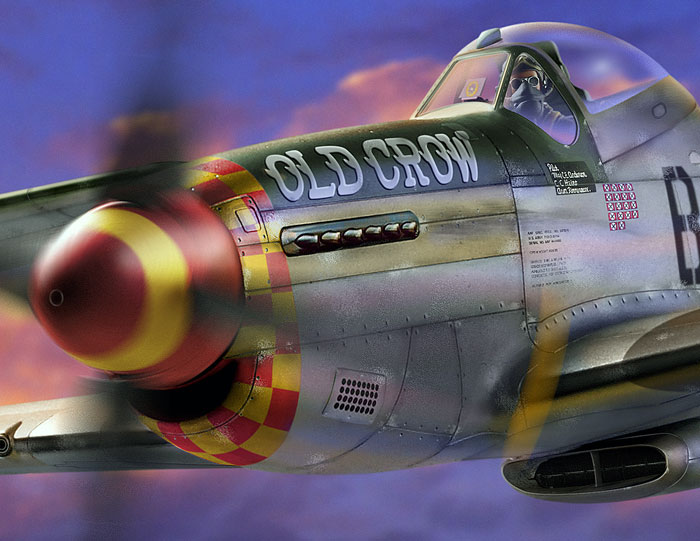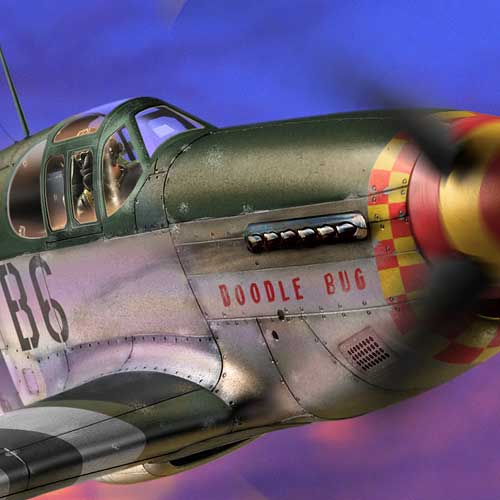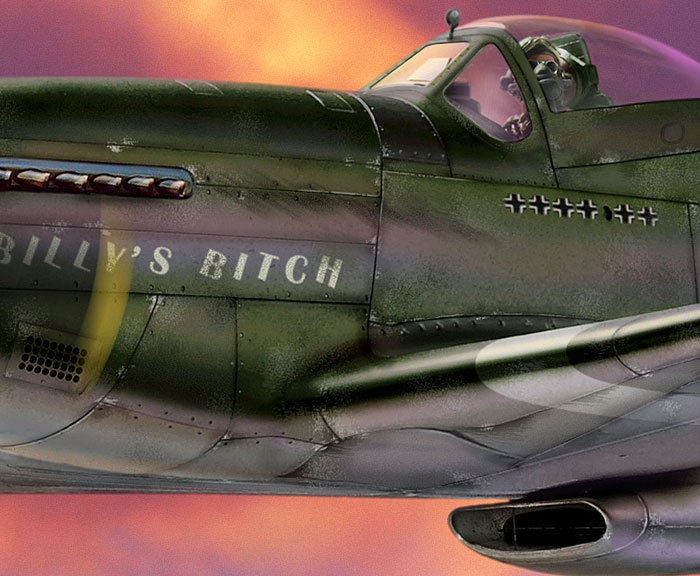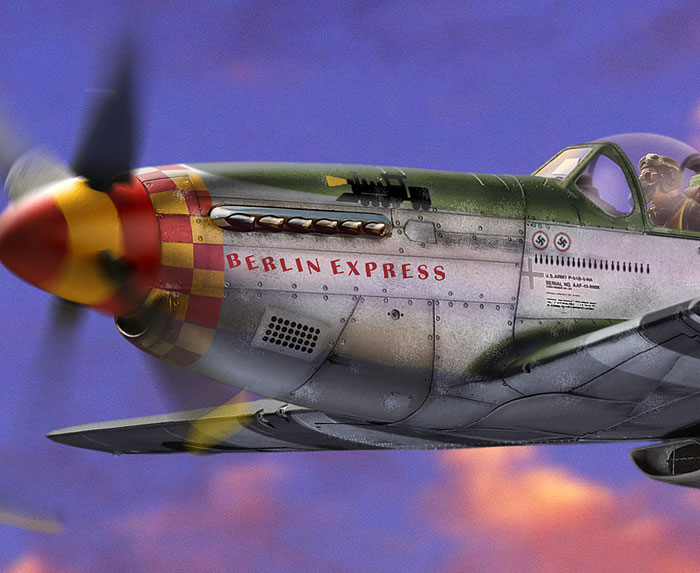|
Finger Four
by
Dan Zoernig


HyperScale is proudly supported by Squadron.com
This project was something I had wanted to do with Col. Bud Anderson
for a long time. I wanted to present him an opportunity to select the
guys he'd most want to be flying with in this image and he came through
with three other pilots who flew every type of model and color scheme
employed by the 357th FG.
His suggestions and technical advice helped me to create this picture
as an accurate "fantasy flight" which prints out at 12x44 inches at 300
dpi.
The legend at the bottom of the print is Col. Anderson's own draft,
and give a little information on each plane and it's pilot.
The image itself is one big Photoshop file, created from 100s of
layers over a period of several weeks.
The sky is 5 separate film shots scanned on a drum scanner and
stitched together in PShop. The planes are Hasegawa and Tamiya products,
heavily retouched in the computer. In fact, the buildups were put
together in about 30 minutes each, then sprayed Testors Silver. All
detailing, weathering, coloring, etc, was done on my Mac G4 in PS6.
Markings and color schemes were researched by Col. Anderson and his son
Jim and then passed on to me. Very fine gentlemen, they are, and I could
not have done this without their help.
Legend written by Col. Anderson:
Finger Four
The Finger Four formation was first used by the Germans during WWI
and then reinvented by the Luftwaffe during the Spanish Civil War. It
was widely accepted by all nations during WW II as the best formation
for combat. The flight consisted of a leader (#1) and his wingman (#2)
joined by an element leader (#3) and his wingman (#4). The flight and
element leaders are the attackers and the wingman’s job is to keep their
leaders aware of any threat from the rear. Look at the back of your
flattened hand and you can visualize how the aircraft are generally
positioned as well as how the name was derived. By flying in a more
spread out manner the formation was very maneuverable and provided wider
visual coverage by the wingmen to the rear. For flying in the weather or
for show the formation flew much closer.
Finger Four depicts four P-51Mustangs from the 363rd Fighter Squadron of
the 357th Fighter Group assigned to the 8th Air Force in the ETO. The
357th was best known as the highest scoring unit in the shortest time,
595.5 enemy aircraft destroyed in the air in 14 months. The unique
aspect of this illustration is that it displays both the variety of
paint schemes and the variants of the Mustangs flown by the Group.

Above, Col. Clarence E ‘Bud’ Anderson then a Major is the flight
leader (#1) flying a classic P-51D s/n 44-414450 B6-S “Old Crow” in
natural aluminum paint scheme. He was a triple ace destroying 16 enemy
aircraft in the air.
1st Lt John Skara is flying as Andersons wingman (#2) in an early model
Mustang with the birdcage canopy painted in a half natural aluminum and
half dark green camouflage paint scheme. “Doodlebug” is P-51B s/n
42-106458 B6-Z.

Captain William R O’Brien, in the element leader position (#3) is flying
a late model Mustang but in a solid dark green camouflage paint scheme.
P-51D 44-13522 B6-G was named “Billy’s Bitch.” O’Bee was an ace with 6
aerial victories.

1st Lt William B Overstreet is the (#4) member of the flight as
O’Brien’s wingman is flying P-51B s/n 42-103309 B6-O. “Berlin Express”
is also in a hybrid pint scheme. This aircraft was equipped with a
Malcolm hood. This type canopy was developed by the British to eliminate
the birdcage and provide better visibility. Overstreet had 2 confirmed
aerial victories.

(Legend for Finger Four courtesy of Colonel Clarence C.E. “Bud”
Anderson, USAF Retired.)
Dan Zoernig is a digital aviation illustrator from St. Louis, Missouri.
Focusing primarily on subjects and events of the Second World War,
Dan uses digital photography and computer retouching to produce
photo-realistic illustrations.
These illustrations are available from the artist printed on either
premium artist's canvas or Somerset 250 gsm acid free watercolor stock.
To see more of Dan's work, you can visit his website
http://www.danzoernig.com/illustrations/default.asp
Image and Text Copyright ©
2006 by Dan Zoernig
Page Created 21 July, 2006
Last Updated
21 February, 2007
Back to
HyperScale Main Page |
Home
| What's New |
Features |
Gallery |
Reviews |
Reference |
Forum |
Search